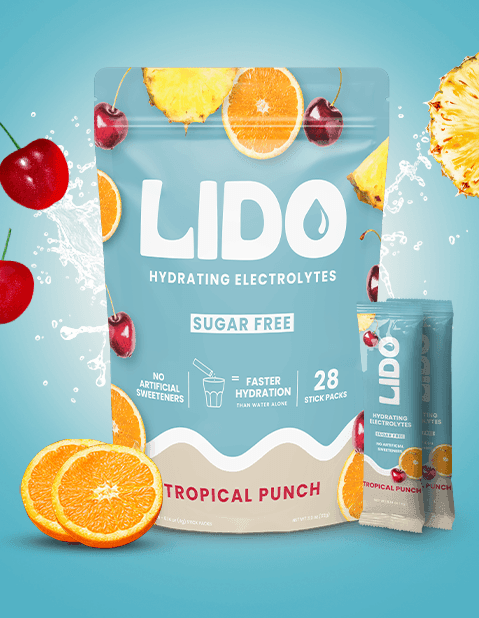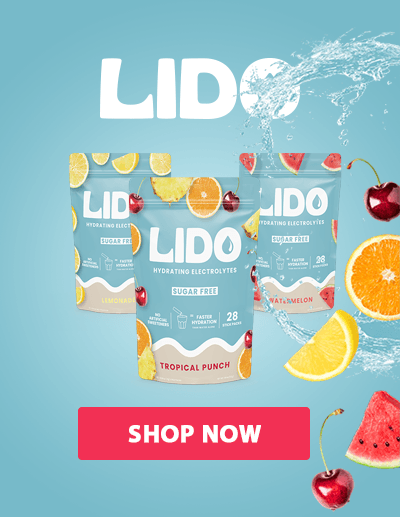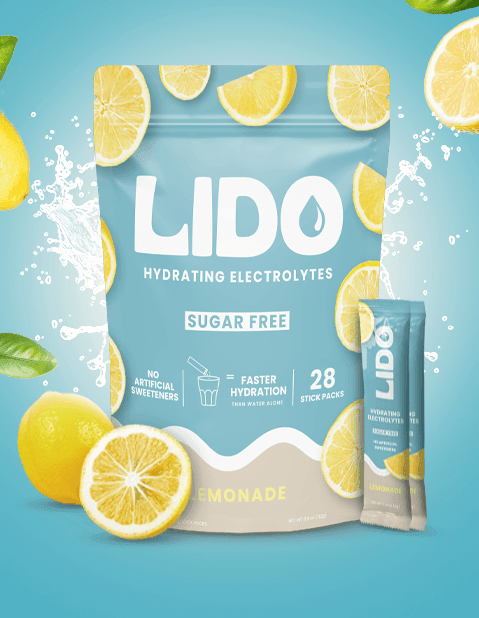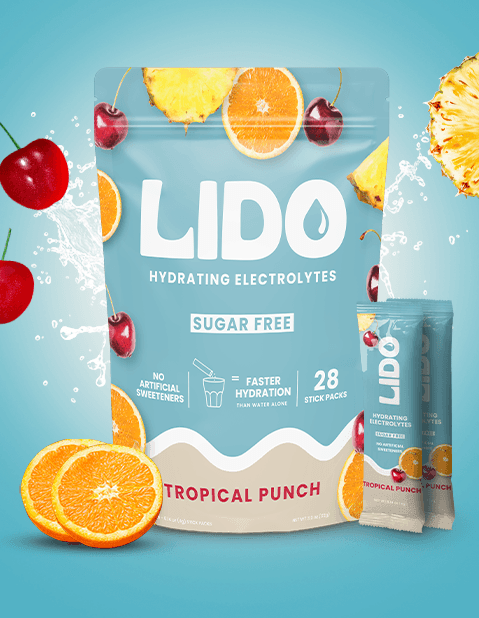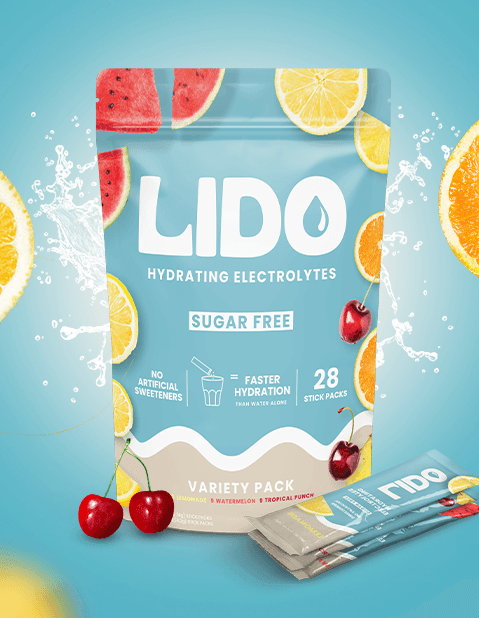Calculating Your Daily Water Intake Needs: A Guide to Staying Hydrated
Jennifer DouglasShare

With water bottles becoming somewhat of a status symbol, you’d think we’d have this whole hydration thing figured out. We’ve got water reminder apps, water containers with time markers and motivational quotes, and even TikTok challenges designed to encourage us to drink more. Yet, there are still no concrete specifics for how much water we should be drinking per day.
To be fair, hydration is highly personal. Plenty of factors affect our individual needs, so recommending a fixed daily allowance for everyone can be problematic. And while there’s the age-old dogma that adults should drink eight 8-ounce glasses (or 64 oz.) of water daily, this amount may be too much or too little for some folks. So, how much water do we really need?
Stick around as we dive deep into everything from why proper hydration matters to how to figure out the key H2O numbers to target daily.
How To Determine Your Ideal Daily Water Intake Goal
Again, there’s no one-size-fits-all rule for how much water to drink per day. Multiple factors will influence what your body and lifestyle require, making it more complicated to determine your ideal daily water needs. Not to mention, drinking isn’t the only way to stay hydrated.
The best way to determine how much water you should drink daily is to consult your medical provider for individual hydration recommendations. However, you can estimate your hydration goals based on various factors, such as the following:
Birth Sex
The physiological differences between men and women impact several things, including how much fluid they store, how they sweat, and how quickly they heat up—all of which can affect one’s fluid needs.
Adult males generally need more water than women because they have larger bodies and less body fat, which contains less water than muscle. Men’s bodies are about 58% water on average, while women’s are about 49%. That’s mainly because men typically have more muscle.
Considering this, the Mayo Clinic recommends the following for both sexes:
- Men: about 15.5 cups (3.7 liters or 124 oz.) of fluids a day
- Women: roughly 11.5 cups (2.7 liters or 92 oz.) per day
These recommendations include fluids from water, other beverages, and food. But of course, these numbers can’t be applied to everyone. They were established for generally healthy individuals, considering age and gender only, and can fluctuate based on other factors like those below.
Weight
Body mass and composition can also impact your fluid needs. According to a paper in the May/June 2024 Annals of Family Medicine medical journal, “Water turnover rates increase with BMI based on higher energy requirements, greater food consumption, and higher metabolic production.” Essentially, your fluid intake requirement raises or decreases with your body weight.
The Academy of Nutrition and Dietetics, which bases its recommendation on a person’s weight, suggests 30 to 35 milliliters of fluid a day per kilogram that a healthy adult weighs. Therefore, for a 150-pound (68.2 kg) individual, fluid needs would be 70 to 80 oz. (2.07 to 2.37 liters). Others suggest taking your body weight in pounds and multiplying it by ⅔ or dividing it by two. Both formulas supposedly give you the amount of water in ounces you should drink daily.
However, remember that these formulas don’t separate water intake from food. So, if you’re eating lots of water-rich foods, the amount of H2O you need to drink could be lower. Also, there are instances where this weight-based approach won’t apply, such as in cases of obesity, malnourishment, or underweight. If you fall into any of these groups, it’s best to seek guidance from a doctor or nutritional expert. They’ll be able to use their clinical judgment to quantify your fluid needs accurately.
Activity Level
You might sweat a lot if you spend enough time exercising continuously or engaging in other physical activities. As the American College of Sports Medicine (ACSM) points out, the intensity and duration of exercise impact how much you sweat and your subsequent fluid needs. The more you sweat—in which you lose water—the more you’ll need to drink to replace what’s lost.
As for how much exactly you should consume, the ACSM recommends an extra 12 ounces of water on top of your daily intake for every 30 minutes that you plan to work out.
- Calculation: Water needs based on weight + [(60 minutes of exercise/30 minutes) x 12 oz.] = oz. of water per day
- Example: 100 oz. + [(60 minutes of exercise/30 minutes) x 12 oz.] = 124 oz. of water per day
Bear in mind, however, that you might need to add more if you’re exercising outside in hot weather, among other factors, including genetics, climate, body size, health status, fitness level, and age.
This is where calculating exact fluid losses from physical activity can confuse most, as there are just too many variables to consider. Two persons of the same weight and gender and with similar diets doing the same workout in the same conditions can produce different amounts of sweat and thus have different fluid needs.
Diet Quality
Your hydration status—and the amount of water you’ll need in a day—isn’t just about what you drink but also what you eat. For instance, fruits such as apricots, blueberries, oranges, peaches, pineapples, plums, and raspberries contain over eighty percent water. Melons such as cantaloupe and watermelon have some of the highest water content, at more than 90 percent.
Similarly, vegetables are more than 80% water on average, but some varieties can contain over 90%. Some vegetables with high water content include:
- Cucumbers (96%)
- Tomatoes (95%)
- Spinach (93%)
- Mushrooms (92%)
- Lettuce (96%)
- Zucchini (95%)
- Celery (95%)
- Radishes (95%)
- Bell Peppers (94%)
- Cauliflower (92%)
Soup is another excellent choice to help you meet your water goals. If you eat enough of these foods daily, you won’t need to drink as much water. But on the flip side, you might need a few extra glasses if you don’t have much of them in your diet on any given day to compensate for your fluid loss.
Life Stage
When you’re pregnant, your body is creating another human. And so, you’re no longer drinking for yourself but for two or more. Your body needs extra fluid to make amniotic fluid and extra blood to cushion your little one (or ones if you’re expecting multiple) and support their development, according to PennState.
Furthermore, pregnancy may also lead to more frequent urination, increased sweating, and morning sickness—all of which means you’re losing more fluids than usual. Staying hydrated helps keep dehydration and its side effects (think headaches, swelling, and even contractions) at bay.
Breastfeeding also significantly increases your daily water needs. Every time you feed your baby; you lose fluids. And since breast milk is about 90% water, your body needs plenty of fluids to ramp up milk production, as the Academy of Nutrition and Dietetics explains.
If you are pregnant or breastfeeding, the American Pregnancy Association advises increasing your fluid intake by 24 to 32 ounces, depending on your weight.
Overall Health Status
There’s a reason doctors often recommend upping your water intake when you’re sick, have various health conditions, are taking certain medications, or are experiencing vomiting or diarrhea. It’s usually because you lose fluids and need to replace them.
Take diabetes, for instance. When your blood sugar is abnormally high, your body tries to flush out the excess glucose through urine. This means more trips to the bathroom and, you guessed it, more water loss. Vomiting and diarrhea also speed up fluid loss as more fluids are expelled from the body. Likewise, when you have a fever, you likely sweat more and need to drink more to make up for the loss.
How To Know If You’re Drinking Enough Water
The color of your urine is typically a good indicator of your hydration status, so take a quick look at it during your next bathroom visit. You’re likely drinking enough if it’s pale yellow (good job!). But if it is dark yellow, it could be a sign that you need to step up your hydration game.
It’s important to note that keeping tabs on your wee color isn’t the perfect way to gauge your fluid levels. Certain health conditions, medications, vitamin B2 supplements, and natural pigments in various foods can cause urine to appear darker, even if you’re adequately hydrated.
That’s why it’s good to know the other signs that your body might be low on water. Dehydration can also manifest itself with the following symptoms:
- Thirst
- Fatigue or feeling tired
- Dizziness or lightheadedness
- Dry mouth, lips, and/or throat
- Headache
- Difficulty concentrating
- Infrequent urination
If you are experiencing any of these symptoms, you might need to drink water and/or add more electrolytes to your diet (more on this later). Even mild dehydration can impair your physical and mental health and performance.
Is Staying Hydrated Really That Important?
Staying on top of your daily hydration is even more crucial than you might realize. Just like a plant needs water to grow and thrive, the body needs ample water to function correctly. Not getting enough fluids in your diet raises the risk of dehydration, which has a bunch of unwanted side effects, per MD Anderson Cancer Center:
- Headache
- Dizziness or lightheadedness
- Sleepiness
- Decrease in urination
- Dark yellow- or amber-colored urine
- Reduced skin elasticity
- Dry mouth and mucous membranes (lips, gums, nostrils)
- Low blood pressure
If you skimp on your water intake over longer periods, the impact on your body can worsen and lead to more severe health issues, such as kidney stones, urinary tract infections, and heat-related illnesses.
On the flip side, not only does good hydration help prevent dehydration symptoms, but it also regulates body temperature, supports digestion, carries nutrients and oxygen to cells, eliminates toxins via the kidneys, optimizes brain function, and much more. It can even help you sleep better, think more clearly, and improve your mood, as the Harvard School of Public Health explains.
Let’s say that staying hydrated benefits your overall health.
5 Easy Ways to Increase Your Water Intake and Stay Hydrated Every Day
Incorporating more water into your diet doesn’t have to feel like a chore (nor do you have to stick to plain old H2O alone to smash your hydration goals). You have many more easy-to-follow options for staying hydrated:
1. Make a habit of drinking water.
Adding more water to your daily routine is one of the best ways to up your hydration. That could mean gulping a glass first thing in the morning or before you head out for the day. This can kickstart your metabolism and help you start the day on a high note. You can also combine drinking water with a habit you know happens regularly (a technique known as habit stacking). Tying those sipping sessions to a workout or mealtime “trains” your body to want water during those times.
2. Set water reminders.
It’s easy to get so consumed in the hustle and bustle of daily life that we forget to hydrate each day. Whether it’s an app on your computer, smartphone, or smartwatch, an attachment on your water bottle, or a sticky note on your desk or refrigerator, setting periodic reminders can help you keep your hydration schedules on track and provide the water your body needs daily.
These notifications can be beneficial if you get too much and often need to remember to hydrate during the day. You can have them go off every hour to help you stay on track with your daily water goals.
3. Carry a reusable water bottle.
What easier way to hydrate than filling up a reusable water bottle and having it on hand wherever you go? If you work from home, keep it close by and take pre-determined breaks to refill it. Work away from home? Keep it on your desk at the office or in your work bag, and refill it at the water cooler if needed.
This simple practice provides a visible cue to remind you to drink up and helps ensure consistent access to water throughout the day.
4. Eat your water.
Did you know that a 154-gram serving of watermelon contains more than 4 ounces of water, along with fiber, vitamin A, vitamin C, and magnesium? There are other water-dense fruits like citrus, oranges, berries, and stone fruits (such as peaches). Adding these to your diet is a great way to increase your fluids.
Similarly, veggies higher in water content can help keep you adequately hydrated. Water-rich veggies include bell peppers, celery, zucchini, lettuce, and tomatoes. Try crunching on veggie sticks with salsa, or add a handful of chopped tomato to your salad.
5. Flavor up your water.
Water is a healthy choice when it comes to warding off dehydration. It doesn’t contain sugar, calories, or other ingredients that could impact your health or hydration. But let’s face it—drinking plain water every day can get boring. You can safely jazz up your water by adding frozen fruit, cucumber slices, basil, or mint leaves. Not only will it be more refreshing, but it might encourage you to drink more.
Electrolytes: The Ultimate Hydration Booster
We lose more than water when we sweat, urinate, or even breathe. We also lose electrolytes—minerals in our blood and other bodily fluids that carry an electric charge.
Electrolytes like sodium are crucial for hydration because they carry water into our cells to create a balance on each side of the membrane. Without these essential minerals, the water we drink would get passed out of the body without being absorbed (which explains why you can drink a bunch of water and still feel dehydrated).
One way to get your daily electrolytes is by using electrolyte mixes. LIDO offers an array of electrolyte powders in travel-sized packets, each containing the perfect blend of sodium, potassium, and magnesium to help ensure a good balance. As an added benefit, they contain zero sugar, calories, or artificial ingredients, making them a healthier alternative to sugar-filled sports drinks. They are also paleo- and vegan-friendly and gluten- and GMO-free if that’s something you care about.
Tear open a pack, add it to your water or other beverage, and enjoy the incredible benefits of optimal hydration.
Final Thoughts
Knowing how much water to drink daily is the first step toward proper hydration. But because everyone’s different, there isn’t a set amount of H2O that applies to all of us. Age and weight are key factors, with activity level, health status, life stage, and other variables further influencing day-to-day water needs.
The best way to determine your ideal water intake goals is to chat with your primary healthcare provider. They’ll be able to help you find the optimal amount of water to drink each day to support your overall well-being. Oh, and don’t forget to ask whether you need to replenish your electrolyte stores so your body actually absorbs the water you drink.
